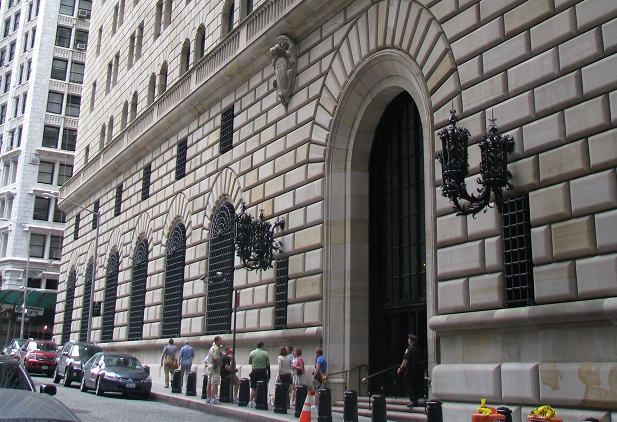 Frederic Mishkin, governor from 2006 to 2008, remembered AlanGreenspan, who had the ability to embarrass colleagues to keep themin line: “like watching a Kill Bill movie'' as Greenspan “slicedup'' dissenters during meetings.
Frederic Mishkin, governor from 2006 to 2008, remembered AlanGreenspan, who had the ability to embarrass colleagues to keep themin line: “like watching a Kill Bill movie'' as Greenspan “slicedup'' dissenters during meetings.
(Bloomberg) –The Federal Reserve last week published oralinterviews with more than 50 policy makers and staff that wereconducted in conjunction with its centennial in 2013.
|The trove includes conversation with former chairs Paul Volcker,Alan Greenspan and Janet Yellen, governors and senior staff, whoserecollections span a half century of steering the world's mostpowerful central bank.
|Here are some of the memories that caught our eye:
|Just a puff
Laurence Meyer, a Fed governor appointed by President BillClinton who served from 1996 to 2002, got a question he did notexpect during his FBI background check.
|“When I met the FBI agent, the very first question he asked was,“Have you ever smoked marijuana?” The question came out of theblue. I never thought he would ask that question. I sat there and Ipaused for a second and thought, “What should I say?” I could say“no” and nobody would ever find out. I was at a party once ortwice, and I had a puff. It wasn't important. But I said to myself,“No, you don't want to lie here.” So I said, “Yes.”
|“I explained the context. Honestly, I had sleepless nightswondering whether that was going to be important. Then I dreamedthat I honestly saw the headline in the paper: “President ClintonWithdraws Nomination from Pot-Smoking Professor.” And then I said,'Clinton? Not a chance.'”
|You'll never have another job
It was 1965. President Lyndon Johnson was in the White House andFed Governor Dewey Daane was heading home from the airport inWashington when his driver informed him that he was wanted over atthe U.S. Treasury for a quick word with an official who “wanted afew minutes” of Daane's time.
|“I walked into his office. This official looked up at me andsaid, 'If you vote for the discount rate increase, the Presidentwill see to it that you never have another job, and I'll help thePresident.' That was his greeting.”
|He voted for the increase anyway.
|Sliced up like 'Kill Bill'
Frederic Mishkin, governor from 2006 to 2008, thought ofdissenting over monetary policy decisions but decided against itafter talking with then-Chairman Ben Bernanke, because “if Idissented it would create a lot of problems for him and for theinstitution. My view in that context was that you provide yourviews, but you're part of a team.''
|The Fed's 12 regional bank presidents, though, felt no suchobligation and Mishkin called them out for talking in public aboutinterest rates and for caring “more about getting their name innewspapers” which he argued made the Fed look bad and hurt itscredibility.
|Lack of message discipline was less of a problem underGreenspan, who had the ability to really embarrass colleagues tokeep them in line. Mishkin said it was “like watching a Kill Billmovie'' as Greenspan “sliced up'' dissenters during meetings.
|Goddamn it
Edward Gramlich, Fed governor from 1997 to 2005, raised an earlyalarm over subprime lending abuses, well before the housing crisisbegan to gather steam. But his warnings failed to stir action tohead off the coming credit crunch that triggered a global financialcrisis.
|“Goddamn it. We have to fix this problem, and we have to fix theproblem before the next cycle,'' Gramlich said he told the KansasCity Fed's conference in Jackson Hole, Wyoming.
|But Greenspan had little interest in consumer issues and “hedidn't trust me,” Gramlich said, foiling his efforts to boostscrutiny of mortgage lenders.
|Is it important?
It was October 1979 and Chairman Paul Volcker was about to takea massive step toward getting inflation back under wraps byadopting a new approach to policy that would raise interest ratesaggressively. In a sign that this was something special, the Fedcalled a highly unusual press conference on Saturday night. But thecentral bank back then didn't operate under quite the same glare ofmedia scrutiny that it does now. Head of public affairs JosephCoyne rang around to make sure the reporters turned up. CBS askedhim “Is it important?'' In the event, the rarity of the occasionensured that the press showed up in force.
|A talk in the desert
Gerald Corrigan, who ran the Minneapolis Fed from 1980 to 1984before taking over in New York until 1993, cheerfully rememberedinstructing Citibank chief John Reed that his bank was in troubleand needed to raise $5 billion in fresh equity “or I'm going to doit for you. Let me know what your decision is.”
|It was November 1989 and the Fed was getting seriously worriedabout bank exposure after a series of massive leveraged buyouts.Reed called Corrigan a month later and said that Saudi PrinceAl-Waleed bin Talal was ready to put up $1.5 billion. ButWashington wanted Corrigan to make clear to the prince that therewould be restrictions on the capital raising.
|“So I went to Saudi Arabia. I was met at the airport and drivenoff into the desert, literally. I didn't know where we were. Iended up in this tent out in the desert, with all the rugs andpillows, and the prince and I had a little heart-to-hearttalk.”
|Copyright 2019 Bloomberg. All rightsreserved. This material may not be published, broadcast, rewritten,or redistributed.
Complete your profile to continue reading and get FREE access to BenefitsPRO, part of your ALM digital membership.
Your access to unlimited BenefitsPRO content isn’t changing.
Once you are an ALM digital member, you’ll receive:
- Critical BenefitsPRO information including cutting edge post-reform success strategies, access to educational webcasts and videos, resources from industry leaders, and informative Newsletters.
- Exclusive discounts on ALM, BenefitsPRO magazine and BenefitsPRO.com events
- Access to other award-winning ALM websites including ThinkAdvisor.com and Law.com
Already have an account? Sign In
© 2024 ALM Global, LLC, All Rights Reserved. Request academic re-use from www.copyright.com. All other uses, submit a request to [email protected]. For more information visit Asset & Logo Licensing.








